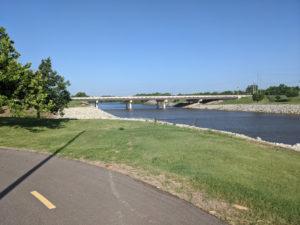 Looking back from the south bank River Trail, this is the Portland Avenue bridge. This is the turn-around point for one of my most frequent loops. I ride across this bridge at least once per week as one of my shorter rides. With the excessive heat last week, I saw this bridge a couple of times, because long rides aren’t really safe when it gets above 90°F.
Looking back from the south bank River Trail, this is the Portland Avenue bridge. This is the turn-around point for one of my most frequent loops. I ride across this bridge at least once per week as one of my shorter rides. With the excessive heat last week, I saw this bridge a couple of times, because long rides aren’t really safe when it gets above 90°F.
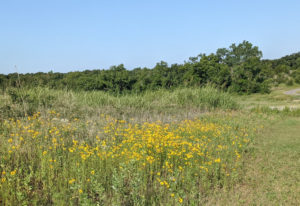 I did make it out to Draper Lake Bikeway once last week when the high was just a few degrees lower. I had to leave the house at about 7AM in order to get back before the heat was too high. Out at the lake, there is currently still enough moisture in the ground from the frequent torrential rains we had a few weeks ago. Thus, I still see flower patches like this. But another week of dry heat will wipe out the berries and the flowers like these. The taller grasses will start to brown.
I did make it out to Draper Lake Bikeway once last week when the high was just a few degrees lower. I had to leave the house at about 7AM in order to get back before the heat was too high. Out at the lake, there is currently still enough moisture in the ground from the frequent torrential rains we had a few weeks ago. Thus, I still see flower patches like this. But another week of dry heat will wipe out the berries and the flowers like these. The taller grasses will start to brown.
 This field produced a good hay crop before the drought hit. It’s pretty rare to see the smaller rectangular bales these days; everyone uses the one-ton bales now. These were mowed and rolled up over a day or so, and they’ll be left out in the sun like this for a week or more before they get collected and put away in the barn at the top of the hill in this picture.
This field produced a good hay crop before the drought hit. It’s pretty rare to see the smaller rectangular bales these days; everyone uses the one-ton bales now. These were mowed and rolled up over a day or so, and they’ll be left out in the sun like this for a week or more before they get collected and put away in the barn at the top of the hill in this picture.
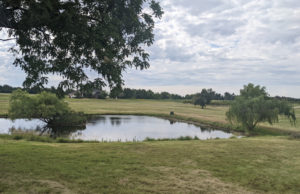 Today was rather cool, so I took a much longer ride. I went out to Harrah and through Jones. Out on the big hill above the Canadian River in the northern Harrah area is the Wind Drift Orchards, producing mostly peaches on this high ridge. This is the owner’s house and a picturesque stock pond out front.
Today was rather cool, so I took a much longer ride. I went out to Harrah and through Jones. Out on the big hill above the Canadian River in the northern Harrah area is the Wind Drift Orchards, producing mostly peaches on this high ridge. This is the owner’s house and a picturesque stock pond out front.
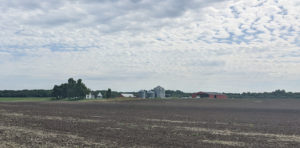 One of the larger commercial farms out in Jones, this one stands just north of the State Center School (the school so named because it stands on the geographical center of the State of Oklahoma). This whole farm runs along the flood bank of the North Canadian River. That means a portion of the crop is always down on a lower level, about a couple of feet below the rest of the farm.
One of the larger commercial farms out in Jones, this one stands just north of the State Center School (the school so named because it stands on the geographical center of the State of Oklahoma). This whole farm runs along the flood bank of the North Canadian River. That means a portion of the crop is always down on a lower level, about a couple of feet below the rest of the farm.
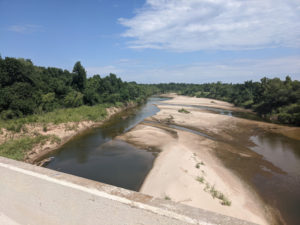 Where I crossed the North Canadian River on Britton Road, the effects of the drought are very painfully clear. It can get just a little bit lower before the state declares some kind of water emergency.
Where I crossed the North Canadian River on Britton Road, the effects of the drought are very painfully clear. It can get just a little bit lower before the state declares some kind of water emergency.


Are those roles up bales really one ton?
That’s what the farmers call them, so I assume their weight is close to that.